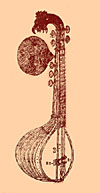The Sanskrit word veena (वीणा) (sometimes transliterated as vina) which is attested already in the Rigveda has designated in the course of Indian history a variety of instruments of various types, as it is a generic term for all kinds of string instruments, just as the Tamil word yaaḻ (யாழ்) (often written yaazh or yaal). In the last centuries and today the instruments designated under the designation veena of which there are several kinds, have tended to be mostly instruments of the lute or cithar type, and recently the word was even applied to modified Western guitars. But the early veenaas could be plucked string instruments of any type.
Found in the list of Musical instruments used by Tamil people out in Tirumurai dated 6th to 11th century
The early Gupta veena: depiction and playing technique
One of early veenas used in India from early times, until the Gupta period and later — this is probably the instrument referred to as veena in a chapter of the Nāṭyaśāstra (नाट्यशास्त्र:) dealing with instrumental music — was an instrument of the harp type and more precisely of the arched harp. It was played with the strings being kept parallel to the body of the player, with both hands plucking the strings, as shown on Samudragupta’s gold coins. It is not possible to tell exactly the number of strings of the instrument on the coin, but descriptions in early literary sources of an ancient instrument called the saptatantree veena (7-string veena) seem to coincide generally with the type of instrument represented on the coin.
The veena has a recorded history that dates back to the approximately 1500 BCE.
In ancient times, the tone vibrating from the hunter’s bow string when he shot an arrow was known as the Vil Yazh. The Jya ghosha (musical sound of the bow string) is referred to in the ancient Atharvaveda. Eventually, the archer’s bow paved the way for the musical bow. Twisted bark, strands of grass and grass root, vegetable fibre and animal gut were used to create the first strings. Over the veena’s evolution and modifications, more particular names were used to help distinguish the instruments that followed. The word veena in India was a term originally used to generally denote “stringed instrument”, and included many variations that would be either plucked, bowed or struck for sound.
The veena instruments developed much like a tree, branching out into instruments as diverse as the harp-like Akasa (a veena that was tied up in the tops of trees for the strings to vibrate from the currents of wind) and the Audumbari veena (played as an accompaniment by the wives of Vedic priests as they chanted during ceremonial Yajnas). Veenas ranged from one string to one hundred, and were composed of many different materials like eagle bone, bamboo, wood and coconut shells. The yazh was an ancient harp-like instrument that was also considered a veena. But with the developments of the fretted veena instruments, the yazh quickly faded away, as the fretted veena allowed for easy performance of ragas and the myriad subtle nuances and pitch oscillations in the gamakas prevalent in the Indian musical system. As is seen in many Hindu temple sculptures and paintings, the early veenas were played vertically. It was not until the great Indian Carnatic music composer and Saraswati veena player Muthuswami Dikshitar that it began to be popularized as played horizontally.
“The current form of the Saraswati veena with 24 fixed frets evolved in Thanjavur, Tamil Nadu, during the reign of Raghunatha Nayak and it is for this reason sometimes called the Tanjore veena, or the Raghunatha veena. Prior to his time, the number of frets on the veena were less and also movable.” – Padmabhooshan Prof. P. Sambamurthy, musicologist. The Saraswati veena developed from Kinnari Veena. Made in several regions in South India, those made by makers from Thanjavur in the South Indian state of Tamil Nadu are to date considered the most sophisticated. Pitapuram in East Godavari District and Bobbili in vijayanagaram District of Andhrapradesh are famous for Veena makers. Sangeeta Ratnakara calls it Ekatantri Veena and gives the method for its construction.
While the Saraswati veena is considered in the lute genealogy, other North Indian veenas such as the Rudra veena and Vichitra veena are technically zithers. Descendants of Tansen reserved Rudra Veena for family and out of reverence began calling it the Saraswati Veena.
